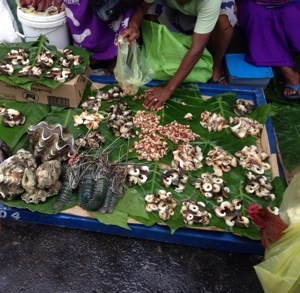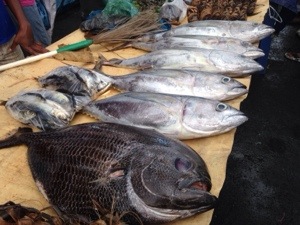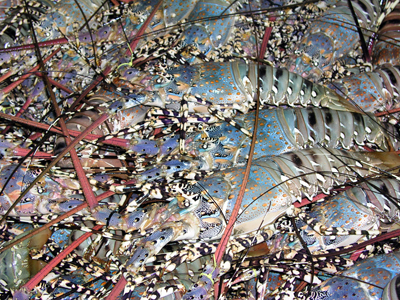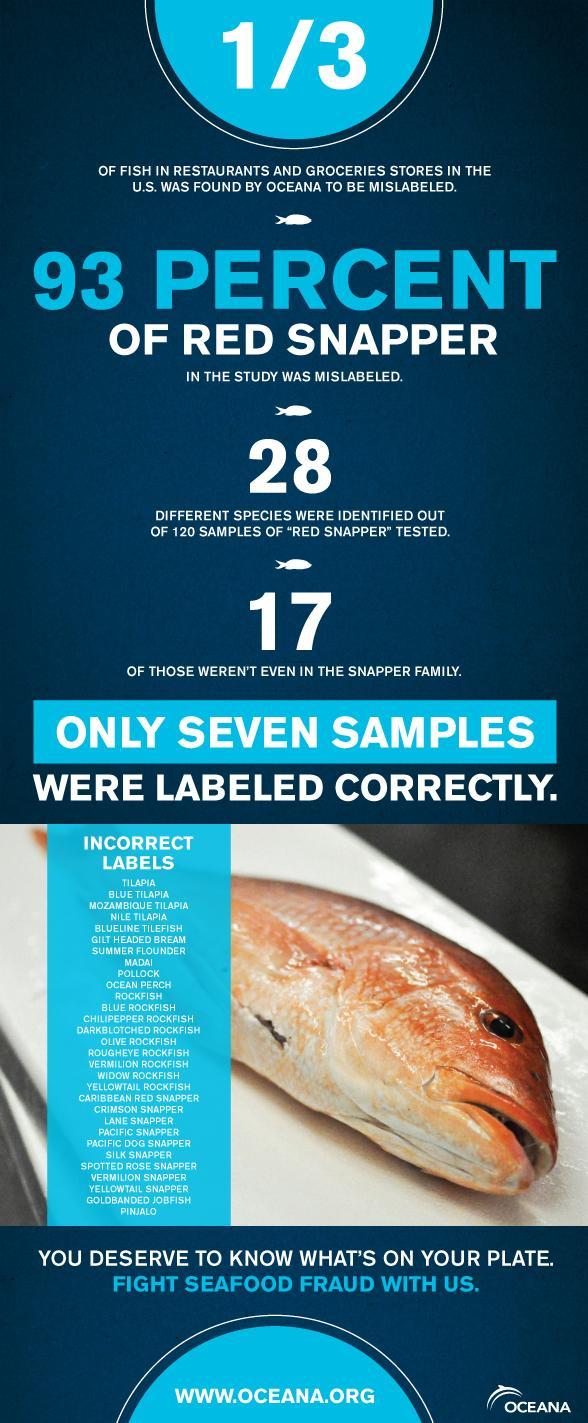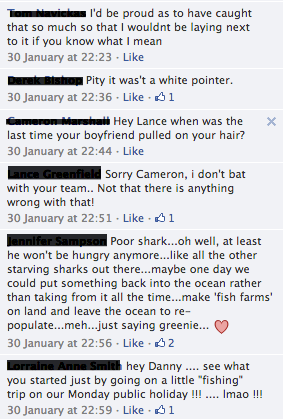I could have spent many hours in the Suva fish market, chatting to stallholders about their catches, changes over time in fishing habits and the like.
This one stall (most of them were little more than old tarpaulins on the ground) had mussels, tropical crayfish and a species of giant clam I couldn’t identify.
The number of yellowfin tuna around the stalls was a healthy sign of the state if Fiji’s tuna stocks. I’ve never felt good about eating fresh bluefin tuna back at home but the availability of yellowfin sashimi at every function meant I’ve now had a lifetime’s worth.
Category Archives: fishing
Suva fish market wandering
Predicting mining impacts on deep sea communities
The complex and little-understood nature of deep sea biological communities needs to be further researched before any deep sea mining licenses are granted in the Central and West Pacific.
Speakers at the 4th Regional Training Workshop: Environmental Perspectives of Deep Sea Mineral Activities in Nadi, Fiji, discussed the potential commercial value of deep sea minerals and the expensive but vital research that should be continued to determine the impacts of mining on abyssal plain, seamount and hydrothermal vent communities.
The four-day workshop, organised by the Secretariat of the Pacific Regional Environment Programme (SPREP) and the Secretariat of the Pacific Community (SPC), aims to build on the work undertaken by the SPC-EU Deep Sea Minerals Project to strengthen governance systems in Pacific Island countries and territories to manage and minimise environmental impacts from mining activities.
Mining companies have yet to start any mining operation in the deep sea but are exploring several zones in the Central and West Pacific, searching for rich deposits of manganese nodules, cobalt-rich crusts and seafloor massive sulphides.
Duke University Marine Laboratory director Professor Cindy Van Dover, who has piloted the Alvin submersible to assess deep sea environments, said mining operations could have potentially long-term impacts on the fish, molluscs, sponge and worm communities of the deep sea.
“A single mining event could have the same impact as a volcanic eruption and it would be no big deal. Multiple events would be different,” she said.
“Hydrothermal vents are likely to be more resilient than anything else … but there’s still potential for things to go wrong.”
Prof Dover said hydrothermal vents, a key target for seafloor massive sulphide mining, were also being utilised for their genetic resources to develop medical, pharmaceutical, cosmetic and therapeutic products.
Dr Malcolm Clark, Principal Scientist at New Zealand’s National Institute of Water and Atmospheric Research (NIWA), said the faunal communities in manganese nodule and cobalt-rich crust environments were very different and mining operations should build in large buffer zones to reduce impacts.
Professor Mike Petterson, director of SPC’s Applied Geoscience and Technology Division (SOPAC), also launched the SPC-UNEP/GRID-Arendal Pacific Marine Minerals Assessment Report and presented Mr Samuela Namosimalua, Permanent Secretary, Fijian Ministry of Local Government and Environment, with copies of the report.
More information on the SPC-EU Deep Sea Minerals Project is available at
A mild recovery: bluefin tuna stocks may be on the rise
After decades of falling stocks of northern (NBT) and southern bluefin tuna (SBT) in fisheries globally, some possible good news: stocks in certain areas appear to be on the rise, according to this Oceana report on a recent ICCAT Standing Committee on Research and Statistics meeting.
I feel like I should automatically qualify that by skipping to the third paragraph of Oceana’s post, which stated:
Scientists say that the models (SCRS is) using are flawed and therefore have little confidence in them, so they will spend 2014 working with more recent data and improving their calculations.
Which makes me think of this piece of gold from 30 Rock:
Just like They Might Be Giants’ Dr Worm, Dr Leo Spaceman is not a ‘real’ doctor but he comes up with some very apt quotes that show how people can trust an academic or medical professional just because they “know science”.
Anyway, some fisheries managers and tuna fishers will be pretty excited about the possible stock rebound but hopefully they’ll err on the side of caution before making any changes to quotas. Here’s some research I put together for a uni report that might shed some light on the Antipodean situation:
“Australia’s SBT catch peaked at 21,500 tonnes in 1982 (Farley, J. H. et al. 2007) and quotas established in 1989 restricted the catch to 5265 tonnes annually.
Japanese long-lining catch peaked at 78,000 tonnes in 1961 and quotas were also introduced to restrict Japan to 6065 tonnes annually.
Illegal, unreported and unregulated fishing for the species is also a major concern with the Commission for the Conservation of Southern Bluefin Tuna finding that ‘substantial and continuous unreported catches of SBT had been taken by longline vessels since at least the early 1990s’ (Polacheck 2012).”
That’s just the Australian and Japanese reported data for SBT – areas of the New Zealand and South African coast are also key fishing grounds, as well as the international waters where self-reporting of catches is still a woefully inadequate system.
In my opinion, we need tougher quotas, not leniency for these ocean hunters.
1. Farley, JH, Davis, TLO, Gunn, JS, Clear, NP & Preece, AL 2007, ‘Demographic patterns of southern bluefin tuna, Thunnus maccoyii, as inferred from direct age data’, Fisheries Research, vol. 83, no. 2-3, pp. 151-61.
2. Polacheck, T 2012, ‘Assessment of IUU fishing for Southern Bluefin Tuna’, Marine Policy, vol. 36, no. 5, pp. 1150-65.
Cracking the code to farming rock lobster
One of the benefits of studying marine biology at Deakin University is the range of successful graduates Deakin can call on to give guest lectures during the semester.
David Francis, who completed the undergrad through to PhD route in aquaculture at Deakin, has been part of a team at the Australian Institute of Marine Science in Townsville, Queensland looking at developing a stable program of rearing farmed rock lobster (crayfish).
The growing and increasingly lucrative market in Australia (and for export) for rock lobster and its impact on wild stocks has understandably concerned crayfishers, fisheries bodies and marine scientists.
Many varieties of rock lobster have low fecundity, larval survival rates and long larval stages (the southern rock lobster Jasus edwardsii has an average larval (phyllosoma) stage of 450 days, while the tropical variety Panulirus ornatus has only 150 days as larvae). Illegal fishing – including licensed crayfishers flaunting size and catch restrictions – has further decimated wild stock numbers in several main fishing grounds.
Apart from the difficulties and expense of farming a species with a long larval stage, Francis’ team also found that creating the right feed formulation was a tough task – larval lobster are notoriously picky and cannot survive on a standard fishmeal diet, so creating the perfect feed became the AIMS team’s key goal.
After investigating the gut contents of wild prey and chemical profiling the tropical lobster larvae, the AIMS scientists were able to formulate a growth-focused feed to take the larvae successfully into the juvenile stage.
Restrictions on funding meant the research has not yet been completed but Francis hopes an aquaculture company can continue to invest in the program and raise a commercial quantity of farmed lobster, helping in the long term to reduce the impact on wild fisheries.
Blue shark attacked by Jaws! Ok, not Jaws but still…
Another one from the “Overhyped Shark Attack” Files, this one is a little more unusual than the common ‘Jaws bites man/woman/pet pitbull’ stories.
Bastion of truth and journalistic excellence*, UK’s Daily Mirror had this report on a blue shark caught by fishermen off Cornwall with reasonably small bite marks sustained by a “10 foot” shark of some description…
Supposed experts are said to be looking into the attack, which happened when one of the fishos hooked a 60lb blue shark and then watched a larger shark – thought to be a great white – takes bites out of the blue before they could pull their catch onboard.
The reporter makes the surprising mention that “Although it usually eats other sea creatures, it attacks between five and 10 humans a year around the world and has killed 29 since 1990.”
Many gossip rags don’t usually admit that white sharks are ravenous for human flesh, so this is a big admission for a tabloid.
More from the fisherman who snagged it:
“The blue shark looked like someone had taken a machete to it.
“There’s nothing round here that can do that sort of damage. I sent the pictures to a shark expert and he believes it could well be a great white.”
Well, that’s sorted then: if an ‘expert’ says so, great white it is! But probably not. Great whites can roam vast distances and aspects such as climate change-affected ocean currents or shortage of food (i.e. seals, not people) may have encouraged one closer to the UK southern coast.
Without more confirmed sightings and review by real experts, we’ll have to wave this off as a poorly-identified mako attacking a small bluey and leave it at that.
*For those not aware of sarcasm, this is a relatively straightforward example. The Mirror sits slightly above other UK papers The Sun and the defunct News of the World for integrity and believability.
Mako shark still seen as trophy fish for local club competition
I was walking with my favourite Park Ranger yesterday on our usual wander near the Warrnambool Breakwater (the long stone wall in the background of these shots) and noticed a crowd around the weigh-in scales.
At first I thought one of the local tuna fishermen had hoisted up a decent fish for the benefit of tourists (who usually don’t appreciate the plight of the southern bluefin, but that’s another story). On making a path through the onlookers, my partner and I were pretty horrified to see a 110kg mako shark on the scale and a few impressed fishermen boasting about the catch.
Of course fishing for various shark species such as mako (Isurus oxyrinchus) and gummy (Mustelus antarcticus) is still legal in Australia (limits vary by state and territory) but hearing one fishermen state this was a “common shark in these waters” made me cringe: they are still heavily fished and listed as Vulnerable on the IUCN Red List.
Hanging one up in front of a crowd helps continue the “man vs shark” stereotype that is continuing to push down shark numbers worldwide, whether for commercial or recreational purposes. Sizing up the shark when it’s caught, using circle hooks and operating on a catch-and-release basis is the only way to go for maintaining healthy shark populations.
Circle hooks more humane choice for sharks, rays and sportfish
Just saw this Southern Fried Science post (nothing to do with chicken, everything to do with shark conservation) about the benefit of using circle hooks – a method I’m yet to try but definitely support.
Here’s their description of the hooks:
Circle hooks are used by recreational and commercial hook-and-line fisheries (and many longliners) to reduce hooking mortality in large fishes, sharks, and bycatch animals like sea turtles. The idea is that the hook more or less works by itself without being set like a J-hook. The shape of the hook prevents swallowing and encourages hooking in the corner of the mouth, where it’s less likely to do serious damage.
Some great shots in the post show how easy it is to remove circle hooks, up against the traditional hook technique. Many fisherman now cut off the barbs from their standard hooks – they may lose more fish but it helps cut down on damage, especially for sportfishing and the difficulty of returning undersize fish once they have been foul-hooked or swallow a barbed hook.
It’s leatherjacket season! Also, this is not a fashion article…
Leatherjackets are amazing fish, in such colourful varieties. In the past two months, I’ve spotted five different species from the Horseshoe to the Yellowfin species (Meuschenia trachylepis) pictured. This species is often seen with the Six-spined leatherjacket, which I mistook this fish for in my original post on Facebook.
Some people have the idea that marine biologists shouldn’t be out fishing for the species we are studying but it can be a great way of identifying fish, learning where they are and aren’t present and the warning signs when stocks start dwindling.
Spearfishing is now one of my favourites sports – it’s low-impact on the marine environment as opposed to other fishing forms, as we target specific fish and only go for the type and size we want.
Obviously some people still abuse catch and size limits as in any form but the crew I dive with all play by the rules (we’re all marine biology undergrads and my partner also works for the government department dealing with fisheries compliance…)
This species has some serious teeth, used for crushing molluscs and slow-moving sessile animals. Anecdotally, leatherjackets aren’t fast-moving like the local zebrafish or bluethroat wrasse – most of the leatherys I’ve seen tend to hide under ledges or in crevices rather than try to outswim their prey.
Red snapper mislabelling rife in US restaurants: Oceana
Global ocean conservation society Oceana published its US National Seafood Fraud Report earlier this year and this week released some choice stats from the report in the graphic below.
The list of mislabeled fish found in restaurants and supermarkets alone is disturbing but the real concern is: where along the chain from trawler to dockyard to fish wholesaler/supplier to store is the mislabeling occurring?
I guess that’s a major problem facing any watchdog of the fishing industry, as is the lack of consumer knowledge when it comes to the fish being bought. Many people could buy a silk snapper labeled as red snapper and be none the wiser and I doubt whether more than 5 per cent of the population could tell one rockfish from another.
But if a green capsicum (pepper) was labeled as a red one in a supermarket, most would be educated enough to know the difference (not including the colour-blind of course).
AMCS puts shark finning back in the news; Danny Green’s shark tale
The Australian Marine Conservation Society is one of Australia’s driving forces in getting Federal Government backing for marine protected areas and their shark finning campaign hit the news again prior to Chinese New Year.
The Daily Telegraph reported last week that not only did the Australian Government (which bans shark finning in our waters) not keep track of shark fin imports but the limited focus on the trade may mean that illegal shark catches and finning is still continuing in Australian territorial waters.
The Australian Marine Conservation Society said it had sourced data from Hong Kong, the capital of the world’s shark fin export trade, and discovered Australia imported 54 tonnes of shark fin between 1998 and 2011.
“The 54 tonnes of fin imported from Hong Kong would be about 4000 tonnes of shark. Even conservative estimates would put this in the order of tens of thousands of individual sharks,” AMCS spokeswoman Jacki Boyce said.
The AMCS said until the beginning of 2012 shark fins imported into Australia were lumped together with other “shark products” under Australian import identification rules.
My previous post on shark attacks mentioned the poor reputation of sharks – spurred on by media misreporting and poorly-researched Hollywood 3D horror films – that is continuing to make it harder for shark conservationists to be heard by the general public.
That doesn’t mean scientists and respected conservationists aren’t trying: David Shiffman and his colleagues over at Southern Fried Science do consistently great work on exposing and debunking shark myths, such as in this recent post.
Even world boxing champion Danny Green was caught up in a recent furore over Facebook photos of the tiger shark he caught near Perth, Western Australia.
The comments on the photos ranged from viewers outraged by the killing of a shark (one described himself as a humanitarian, which I agree didn’t make sense in this context) to the usual “Good on ya for killing Jaws” and plenty of mud slinging – a screen grab of one selection is below.
It showed once again that the shark debate is fraught with misinformation about shark attacks; that personal opinion often stands above scientific evidence where sharks are concerned and lastly, that we all need to be doing more to show people what these amazing sea creatures are really all about.
